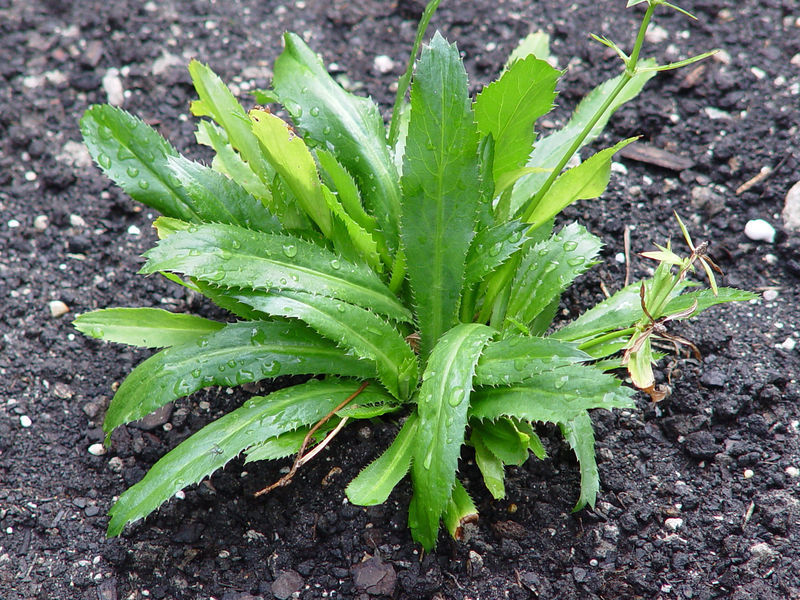A good (fish, goat, mutton, chicken) curry always has this key ingredient!
Shandon beni is a leafy herb native to the West Indies and Central America. It is widely used in the cuisine of these regions, and it also appears in Asian foods. Mexican coriander, Donnia, Spiritweed, Chandon beni, Shadow beni, Bandanya, these are just some of the many names it goes by. Shandon beni is a member of the Apiaceae family, which includes carrots, celery, parsley, and parsnip. It is used as both a culinary and medicinal herb. In food, the leaves are often added during cooking because it has a very strong flavor and aroma, which diminishes nicely under heat.
As the name “culantro” (Eryngium foetidum) suggests, it tastes very much like cilantro, with a somewhat stronger and more lingering flavor. But they are not the same. Its flavor is often utilized in marinades and sauces, and the herb is also used as a garnish and to dress various foods.
Description of Shandon Beni Plant
- Height – The average height of Shandon beni plants ranges from 25 cm to 30 cm.
- Leaves – The leaves grow are rosettes with each leaf growing between 25 and 30 cm.
- Flowers – These plants bear blue flowers.
- Aroma – Entire plants have a strong pungent fragrance. The fresh aroma of these leaves resembles that of cilantro; however it is much stronger than cilantro
Origin Of Shandon Beni
Shandon beni is native to Mexico, Central and South America. It thrives in sub-tropical and tropical climates, and can now be found growing throughout the Caribbean (Trinidad and Guyana). In the United States, the plant is available through seed companies and has started to find a place among Latin American and Caribbean chefs. It can also be found in South American specialty stores.
Nutritional Value Of Shandon Beni
The leaves of these herbal plants are rich in calcium, carotene, iron and riboflavin. They are also a good source of various vitamins including vitamins A, B1, B2 and C. Other nutrients include protein, fat, carbohydrate and phosphorus.
Here Are 6 Health Benefits Of Shandon Beni
- Eliminates bad breath – On a general note, Veggies like parsley have been known to act as a remedy for bad breath. Since parsley and Shandon beni belong to the same family of Apiaceae. Shandon beni can also be said to solve issues regarding bad breath. The fresh scent from shandon beni and high chlorophyll content suggest that it has some deodorizing effect. To use it for bad breath, chew on fresh leaves after each course meal to eliminate the effect of Sulphur compounds which are the actual causes of bad breath.
- Lowers Glucose – It has been revealed from research that leaves and stems from shandon beni help lower blood sugar levels in animals. It can lower body Glucose because of Vitamin B2 (Riboflavin) present as a nutritional supplement. Riboflavin encourages a healthy Liver function which can release insulin hormone more effectively. Since a healthy liver is equal to a balanced body sugar level, it is only relevant to take a dietary supplement of shandon beni with a meal. You can chop shandon beni leaves coarsely, grind stems finely and then add this to salads, salsas, and smoothies to lower your sugar and reduce diabetic risk.
- Asthma – Asthma is a common disease related with lungs. It intensely affects people living in industrialized areas where there is a prevalence of heavy metals, dust, and toxic gas emissions. However, recent researchers have found that plants are excellent sources of medicine that can help cure asthmatic conditions and shandon beni is one of such herbal plants.
- Pain Relief – Shandon beni is generally known to reduce inflammations around the body parts such as bone joints, muscle contractions and a host of other body pains. To efficiently use Shandon beni as a pain reliever; cut out the leaves and boil them, apply the hot Shandon beni water on your body parts or drink it.
- Prevents Neurological inflammation – Regular dosage of Shandon beni on one’s diet helps retracts diseases associated with the brain. Neurodegenerative diseases including Alzheimer’s, Parkinson’s can be prevented as a result of its natural constituents that can reduce inflammations in the brain cells.
- Detoxification – Regular intake of shandon beni helps reduce the occurrence of toxins in the human body mainly due to the presence of vitamin B2 that aids liver function in the body. The liver performs the function of eliminating some toxic wastes from the body system.
Culinary Uses Of Shandon Beni
- Fresh leaves are used as a flavoring in food, e.g. in soups, curries, stews, rice and fish dishes.
- Tender young leaves are eaten raw or cooked, as a vegetable.
- Aromatic herb is used to increase taste in various curries.
- It is also used to add in chutneys, torka etc. for its attractive flavor and taste.
- Leaves can be steamed and served with rice.
- Root is used as a flavoring in soups.
- Seed is used as a flavoring.
- Leaves are used to season meat and other foods in Caribbean, Latin American and Asian cuisines.
- In Latin America, the leaves are often added to salsas, a spicy, tomato-based sauce that is eaten with tortilla chips.)
- Shandon beni leaves can be used to prepare a variety salsas, gravies, barbecued foods and even appetizing drinks.
- Fresh leaves can be used in salad.
Traditional Uses Of Shandon Beni
- Root decoction is taken as a sudorific, diuretic, febrifuge, abortifacient, stomachic and stimulant.
- Juice or a decoction of the leaves is used as a stimulant, as a laxative and as a remedy for colds and fever.
- Decoction of the whole plant is said to lower blood pressure, to be a potent emmenogogue and abortifacient, and is also used as an aphrodisiac.
- Decoction of the whole plant is used as an anti-malarial and for the treatment of hemorrhages.
- Plant is boiled and the water used for a herbal bath or as a medication for chicken pox and measles.
- The leaves are febrifuge, laxative.
- An infusion is used to treat chills, grippe, fevers, head colds, as a children’s purgative.
- Decoction of the crushed leaves is used as a treatment for children’s leprosy and children’s convulsions.
- An infusion is used to treat hydropsy and stomach pains.
- Leaf shows antimicrobial activity.
- It is reportedly used in traditional medicine for burns, earache, fevers, hypertension, constipation, fits, asthma, stomachache, worms, infertility complications, snake bites and also in malaria.
- Tea prepared from the leaves is used to treat fever, flu, diarrhea, constipation, and vomiting.
- It is also thought to promote menstrual bleeding.
- Plant is used in traditional medicines for fevers and chills, vomiting, diarrhea and in Jamaica for colds and convulsions in children.
- Leaves and roots are boiled and the water drunk for pneumonia, flu, diabetes, constipation, and malaria fever.
- Root can be eaten raw for scorpion stings and in India the root is reportedly used to alleviate stomach pains.
- Leaves themselves can be eaten in the form of chutney as an appetite stimulant.
- Decoction of whole plants used as antimalarial.
- In Mizoram, India, decoction of fruits used in dysentery.
- Leaf juice applied to forehead for fever.
- Ethnic communities in the Kodagu district of Karnatak use the leaf decoction against gastrointestinal disorders and the leaf paste for wound healing.
- It can also help with asthma, it lowers the blood pressure, and it helps with epileptic seizures.
- It has a calming effect and it soothes away the seizures.
- It also soothes away the headaches when you drink its tea.
- Leaves and roots are boiled and the water drunk for treating pneumonia, flu, diabetes, constipation, and malaria fever.
- Crushed leaves are placed in the ear to treat pain, and are used for the local treatment of arthritic processes.
- Plant is useful for female reproductive problems such as infertility, childbirth complications, menstrual pains, ease of delivery, postpartum abdominal pains, and vaginal infections and as an emmenogogue.
- Decoction of the whole plant is used to ease delivery, but is contraindicated for pregnancy because it is reported to provoke uterine contraction in Brazil.
NOTE: Decoction – the liquor resulting from concentrating the essence of a substance by heating or boiling, especially a medicinal preparation made from a plant.
Side Effects
There are no known side effects of this herb; however it may cause allergic reactions in some people. Over consumption may also cause some adverse health effects.
Facts About Shandon Beni
- In Java, the plant is fed to cattle as fodder.
- Fragrance emitted from the leaves is somewhat like crushed bedbug.
- Flavor of Shandon beni is diminished after it flowers; so leaves are typically harvested before the plant develops its flower stems.
- An essential oil can be distilled from the seed.
- Various insects keep away from these plants as they do not like the pungent smell the plants.
- The flower heads of these herbal plants attract many beneficial insects like lacewings and ladybugs.
- Shandon beni is also known as “Fit weed” as it can fight epileptic seizures or fits.
Shandon Beni
Culantro aka Shandon beni is a wild herb native to the Caribbean and central America. It has many traditional and culinary uses and along with many health benefits. It has a strong pungent flavor and so it’s not to many people likings. It is grown in many home gardens around the world.







